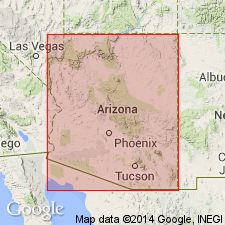
- Usage in publication:
-
- Blue Point Tongue
- Modifications:
-
- Named
- Biostratigraphic dating
- Dominant lithology:
-
- Sandstone
- AAPG geologic province:
-
- Plateau sedimentary province
Summary:
Is formally named as a lower tongue of the Upper Cretaceous Toreva Formation. Type section: on west side of Blue Point, NE1/4,SW1/4,SW1/4,NW1/4, sec 36, T27N, R14E on Hopi Indian Reservation, Coconino Co, AZ (Plateau sedimentary province). Is a prominent tongue of the Toreva noted by Repenning and Page (1956) and referred to as the sandstone tongue of the Toreva by Peterson and Kirk (1977) and Franczyk (1988). At type, unit is cliff-forming sandstone 5.42 m thick; locally thins and thickens from 2.5 m to more than 8 m laterally over distances of 100 m or less. Lower contact gradational through 10 m of interbedded mudstone and argillaceous sandstone; locally, lower contact characterized by ball-and-pillow structures as thick as 2 m. Is separated from main body of Toreva by 6.7 m of nonresistant sandy shale and argillaceous sandstone, which thins to 2 m 0.8 km to south at erosional edge of tongue and thickens to over 10 m, as shale content increases, to north. Is yellowish-gray (5Y 7/2) in color, capped by medium to dark brown (5YR 6/4-4/4) fossil-rich interval; is fine- to medium-grained subfeldspathic to feldspathic arenite; calcite has replaced much of the feldspar, which is dominated by untwinned orthoclase and plagioclase, with minor coarsely twinned microcline; has low- to medium-angle cross-bedding, with top 30 to 40 cm consisting of planar to rippled beds 5-10 cm thick; upper third commonly contains oblate sandstone concretions 20-30 cm across and unusual horizontally directed spiral concretions. Contains abundant, diverse mollusk fossils, but lack of ammonites and inoceramids in the cross-bedded sandstone part indicates deposition on landward side of a sand shoal; abundant ammonites occur at top indicating open marine setting. Is assigned to middle Turonian COLLIGNONICERAS WOOLLGARI REGULARE Subzone.
Source: GNU records (USGS DDS-6; Denver GNULEX).
For more information, please contact Nancy Stamm, Geologic Names Committee Secretary.
Asterisk (*) indicates published by U.S. Geological Survey authors.
"No current usage" (†) implies that a name has been abandoned or has fallen into disuse. Former usage and, if known, replacement name given in parentheses ( ).
Slash (/) indicates name conflicts with nomenclatural guidelines (CSN, 1933; ACSN, 1961, 1970; NACSN, 1983, 2005, 2021). May be explained within brackets ([ ]).

